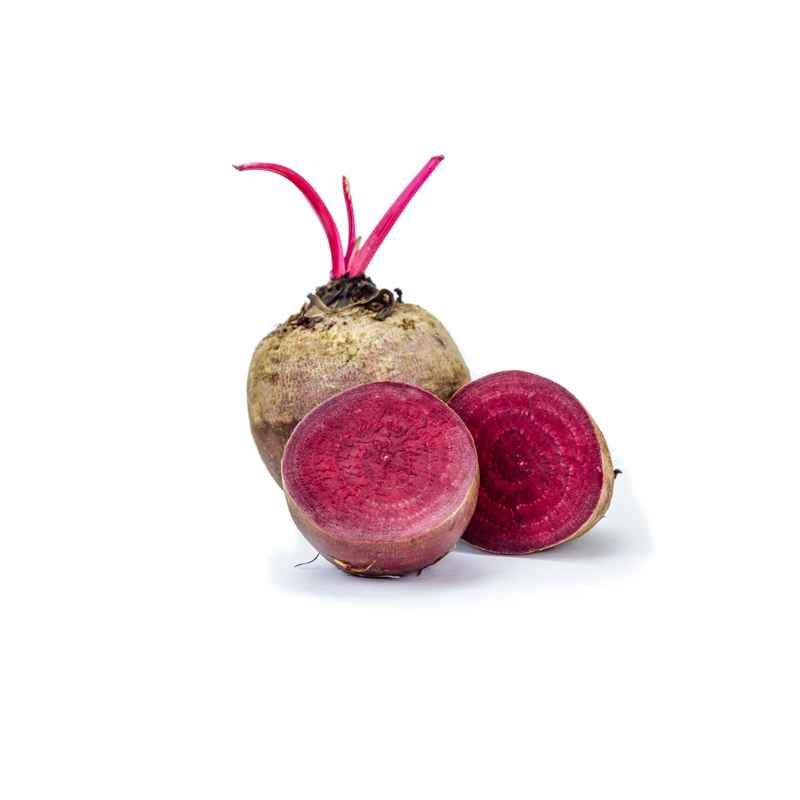
KEY FEATURES
Beetroot (Beta vulgaris var. esculenta) is one of the root vegetables, just like carrots or turnips. Like them, it has the particularity of developing reserves of carbohydrates (sugars) during the last phases of its vegetative development. It contains 8 to 10 g per 100 g, ie more than most fresh vegetables (in which the rate of carbohydrates is around 2 to 4 g per 100 g). Like the sugar beet (of which it is a close relative), the red beet has the characteristic of having its carbohydrates consisting almost exclusively of sucrose:
Read more
it represents more than 90% of the total carbohydrate. They are accompanied by small amounts of pentosans and hexosans (carbohydrates with 5 and 6 carbon atoms), as well as traces of glucose and fructose.
Because of this relative carbohydrate richness, the energy intake of beets is rather high for a vegetable: on average 40 kcal (167 kJoules) per 100 g. It comes mainly from carbohydrates, the other energy constituents – proteins and lipids – being present only in low proportions (respectively 1.5 g and 0.1 g per 100 g).
The fibers of beetroot are abundant, since they reach 2.5 to 3.1 g. per 100g. Most of it (80% of the total) is insoluble fiber (cellulose and hemicellulose), which forms the walls of plant cells and is largely responsible for the consistency and texture of this vegetable.
Beetroot has also accumulated many minerals and trace elements during its plant growth. They are abundant (more than 1000 mg per 100 g) and well diversified. Potassium comes first, with a content that exceeds 300 mg per 100 g. It is followed by sodium, which is around 60 mg (a high level for a vegetable). Calcium (29 mg per 100 g) and magnesium (25 mg) intakes are quite high. In addition to iron, copper, zinc and manganese, beets also contain substances such as boron, chromium, nickel, fluorine, selenium, micronutrients that are very useful in cellular metabolism.
Red beets are well endowed with vitamins, and in particular group B vitamins (which are essential for the proper assimilation of carbohydrates by the cells of the body). Vitamin B9 (or folic acid) is particularly well represented, with a content of 83 µg per 100 g. Vitamin C reaches 10 mg per 100 g in raw beets, and another 5 mg in cooked beets. Finally, there are also small amounts of vitamin E (0.047 mg per 100 g).
THE NUTRITIONAL AND DIETARY
A quality mineral intake
Beetroot provides a wide range of minerals, and in particular contribute to recharge the body of potassium, which acts to regulate blood pressure and allow the transmission of “nervous energy. It is also involved in hedging needs Magnesium: a 100g serving of beets provides 6-7% of the recommended daily intake. Please note that because of its natural wealth in sodium, it must be consumed in moderation in a very strict low sodium diet.
Effective fiber
Rich in fiber, beet helps fight against laziness intestinal its cellulose and hemicelluloses are indeed very effective in stimulating bowel movements. These fibers are tenderized by cooking: the beet is better tolerated by sensitive intestines when eaten cooked. When serving it raw, it is recommended to grate very finely. The beet fiber also slow down the property and regulate the absorption of carbohydrates, which are metabolized and more gradually.
A useful supplement vitamin B9
Beetroot contains appreciable amounts of Vitamin B9 (folic acid or) necessary for cell division and protein synthesis. A deficiency of this vitamin can cause fatigue, loss of appetite and a particular form of anemia called megaloblastic it would also promote the occurrence of cardiovascular disease. The recommended daily intake for vitamin B9 is 300 µg (it is increased in pregnant women), and is currently estimated that 5-10% of young women and elderly do not have adequate intakes of this vitamin. Therefore, the consumption of foods that provide good amounts should be encouraged. Beetroot can thus play a useful role as a source of folic acid, since a portion of 100 g only, we can cover 28% of the daily intake recommended.
THE AVERAGE COMPOSITION TABLE
Average composition * for 100 g net
Components (g)
Carbohydrates 8.40
Proteins 1.50
Lipids 0.10
Water 86.2
Dietary fiber 2.50
Minerals (mg)
Phosphorus 45.00
Calcium 29.00
Magnesium 25.00
Sodium 58.00
Boron 2.100
Iron 0.900
Copper 0.080
Zinc 0.340
Manganese 0.150
Nickel 0.008
Fluorine 0.020
Vitamins (mg)
Vitamin C (ascorbic acid) 10.00
Provitamin A (carotene) 0.011
Vitamin B1 (thiamin) 0.020
Vitamin B2 (riboflavin) 0.040
Vitamin B3 or PP (nicotinamide) 0.230
Vitamin B5 (panothenic acid) 0.130
Vitamin B6 (pyridoxine) 0.050
Vitamin B9 (folic ac.) 0.083
Vitamin E (tocopherols) 0.047
Energy intake KCalories 40.00
This is an average composition for information: the values are to be regarded as orders of magnitude, which vary depending on variety, season, degree of maturity, growing conditions, etc.. From: “Global Directory of Food”, REGAL (1995) – “Minerals” (1996), “Composition of Foods”, Marigold, Fachmann and Kraut, “The Composition of Foods”, Mc Cance and Widdowson.

Harvest From Epoque


Period of Marketing


